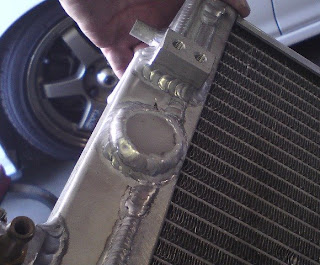

We also made the mounting brackets for the radiator itself.
The Day to Day Operation of Blast Racing



 Mr. Wakita was the one who tuned the car originally, so Jake and his team decided to bring the car to us. The build order was simple and to the point: build a motor that was bulletproof.
Mr. Wakita was the one who tuned the car originally, so Jake and his team decided to bring the car to us. The build order was simple and to the point: build a motor that was bulletproof.




 Below is the completed motor
Below is the completed motor The motor's all put together, and now all that's left is to put the motor in. But not until we clean up all the hoses and wiring.
The motor's all put together, and now all that's left is to put the motor in. But not until we clean up all the hoses and wiring. 

The car is now completed. With the aluminum rods, forged CP pistons, and the Exedy Twin plate, the car literally revs like a motorcycle. The car is insane. Every car guy should be able to experience this in a lifetime. Very very responsive.
I can't wait to take this car to the dyno.

 It got a MCR front bumper, Z-tune fenders, side skirts, a GIANT SARD GT wing, and some Volks.
It got a MCR front bumper, Z-tune fenders, side skirts, a GIANT SARD GT wing, and some Volks. Here’s the old inlet
Here’s the old inlet And here’s the new one
And here’s the new one This is why it wouldn’t have fit.
This is why it wouldn’t have fit.
 One thing I've noticed about people in this industry (myself included) is that many of us don't take our own advice. It might be with the frequency of oil changes, the amount of boost we run, or going cheap on a manifold... whatever. Maybe this is because the labor is free. (not really free, but there's no out of pocket expense) I don't know. But for whatever reason, most mechanics will try a part out on our own car that we'd tell a customer to NEVER under ANY circumstance even think about buying. Well this is what happens when people don’t take their own advice… Twice…
One thing I've noticed about people in this industry (myself included) is that many of us don't take our own advice. It might be with the frequency of oil changes, the amount of boost we run, or going cheap on a manifold... whatever. Maybe this is because the labor is free. (not really free, but there's no out of pocket expense) I don't know. But for whatever reason, most mechanics will try a part out on our own car that we'd tell a customer to NEVER under ANY circumstance even think about buying. Well this is what happens when people don’t take their own advice… Twice… You can clearly see daylight through the manifold... but wait, there's more!
You can clearly see daylight through the manifold... but wait, there's more! And another crack. This manifold lasted a little over two months before it gave out.
And another crack. This manifold lasted a little over two months before it gave out. Here's the "upgraded" version of the last one. There were a couple of extra ribs and gussets that made this manifold a little more promising, but looks can be deceiving. This one lasted a whopping TWO WEEKS!
Here's the "upgraded" version of the last one. There were a couple of extra ribs and gussets that made this manifold a little more promising, but looks can be deceiving. This one lasted a whopping TWO WEEKS! As you can see in this picture, the revisions designed to stiffen up this manifold didn't quite hold up. I just couldn't keep the day light out and the exhaust in.
As you can see in this picture, the revisions designed to stiffen up this manifold didn't quite hold up. I just couldn't keep the day light out and the exhaust in.
We searched the shop for a turbo that would work, but we came out empty handed. Since 200hp was the goal of the car and we had a SR20 red top turbo laying around the shop, we decided to weld a T25 flange on the manifold and call it a day.




 And here are the rear.
And here are the rear. 

There are many ways to judge a quality of a product. For an oil cooler, the obvious measuring stick is the cal/H. It's an universal mesurment, and just about every manufacturer lists it in their catalogs. Other considerations are pressure drop, filter relocation, and a thermostat.
But what good is a big efficient cooler if the air just goes around it?
Which brings me to my point, and a universal law, that you get what you pay for. Perhapse the best oil cooler kit for the GTR is the Nismo. Obviously, it's VERY well thought out, comes with all kinds of goodies, and it makes full use of the core with some very nice ducting. Here's the bad news--it's nearly $2000.  We don't have any cars with a Nismo Oil Cooler, so this is from the Nismo catalog.
We don't have any cars with a Nismo Oil Cooler, so this is from the Nismo catalog.
A more affordable option is the HKS kit. This kit, pictured below, is $800 which is actually reasonably cheap. They kept the cost down by going with a sandwich adaptor, not including a filter relocation, but it does come with -12 lines and a thermostat.

There's a feature that I wished all oil coolers had--a drain. It seems like such an obvious concept, but I've yet to find an oil cooler with one, so this is what we did.



 And from a different angle...
And from a different angle... It's not just the mounting that's different. Since the whole subframe design is entirely different between the two models, so are the lines. Instead of fabricating lines from scratch, we opted to use/modify the GTR and GT-t lines. A little time on the lathe and a little brazing later, it was all done.
It's not just the mounting that's different. Since the whole subframe design is entirely different between the two models, so are the lines. Instead of fabricating lines from scratch, we opted to use/modify the GTR and GT-t lines. A little time on the lathe and a little brazing later, it was all done.



 Although unrelated to the oil starvation issue, another reason not to use this head. This motor has had it...
Although unrelated to the oil starvation issue, another reason not to use this head. This motor has had it...
